Water Quality
Under Review
The Scientific Services Section forms an integral part of CWA’s operation by proving environmental and Scientific support to the Organization. With the increasing demand for good and safe water across the island, the CWA has the mandate to monitor the quality of treated water being supplied to all consumers. Henceforth, prior to the distribution of the water in our system, the Water Quality Laboratory ensures compliance with the WHO Guidelines and National Drinking Water Standards by performing different tests on water.
The Scientific Services Section is composed of three laboratories. The Chemistry and Microbiology Laboratories are accredited for ISO 17025, ensuring that the Quality Management System and Testing Services meets International Standards. The third laboratory, which is also being prepared for accreditation, has been established for the enumeration and identification of Micro-Algae in our reservoirs.
Laboratory Quality Management System: ISO/IEC 17025:2017
The Water Quality Laboratory of the CWA is accredited since May 2012 to the ISO/IEC 17025 by MAURITAS for 21 Chemical and Microbiological parameters.
MAURITAS is a signatory to the International Laboratory Accreditation Cooperation Mutual Recognition Arrangement (ILAC MRA) since October 2018. ILAC is the International Authority on Accreditation regrouping all national accreditation bodies, and MRA provides confidence to end users of laboratories that the results have been generated by technically competent body.
This means that the results produced by the accredited laboratory are technically valid and reliable. Therefore, they can be accepted locally and internationally; enhancing consumer confidence, minimizing the risk of supplying water not conforming to standard and allowing the authority to make decisions on the quality of water.
Furthermore, the EPA 2002 requires that only environmental data provided by an accredited body shall be admissible evidence in any proceeding before a court of law.
The Key Activities of the Scientific Services Section

Chemistry Section
An average of 250 water samples is tested in the Chemistry laboratory, approximating for 4,500 physico-chemical parameters, on a monthly basis. Water samples are collected from impounding reservoirs, service reservoirs boreholes, water treatment plants, pressure filters and from the water distribution system of the CWA.
In line with the Government’s commitment to provide 24/7 water supply to the population, 21 additional pressure filters are currently in operation throughout the island and regular monitoring of the quality of treated water emanating from these filters are performed. The average percentage compliance to standards for the period of July 2018 to June 2019 is 97.1 %.

Daily Process within the Chemistry Laboratory

Below are pictures and details of some equipment being used in the Chemistry Laboratory
pH Meter & Conductivity Meter
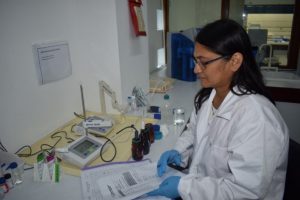
The pH of water is very important since it gives an opinion on the quality of water i.e. fluctuating from very acidic to very alkaline water. The pH of clean water safe for drinking ranges from 6.5 to 8.5. Therefore, a pH meter is used.
The Conductivity meter is also used which analyses the conductivity (which how much dissolved substances, chemicals, and minerals are present as impurities) in water. The Apparatus also gives the values for Total Dissolved Solids as well as salinity of water. Conductivity can however be also affected by the temperature of water; the warmer the water, the higher the conductivity, which is one of the reasons why water has to be analysed at room temperature.
DR6000 Spectrophotometer


The Spectrophotometer is an advanced method used to quantify the amount of analytes present in water.
The benchtop Spectrophotometer UV-VIS (190-1100nm) measures the amount of photons (the light intensity) absorbed after it passes through a sample solution, hence the amount or concentration of a known chemical substance can be determined.

The more concentrated the sample is with the specific chemical substance, the darker is the colour at the addition of powdered chemicals into the sample.
Examples of parameters tested using the Spectrophotometer are: Nitrate, Total Reactive Phosphorus and Chemical Oxygen Demand.
Ion Exchange Chromatography
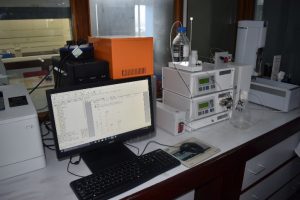
This apparatus has the ability to quantify the amount of dissolved analytes present in water by separating the ions (anions and cations) and the polar molecules (which are molecules with atoms having differences greater than 0.4 in electronegativity- tendency of atoms to attract a shared pair of electrons towards itself). The molecules are separated according to their charges.
Anions that can be separated are fluoride, chloride, nitrite, nitrate, bromide, phosphate and Sulphate.
Sodium is the actual Cation being analysed.
Ultra Performance Liquid Chromatography
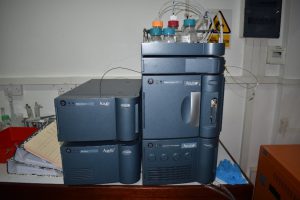
UPLC- Ultra Performance Liquid Chromatography is hereby used in the laboratory for qualitative and quantitative analysis of some less volatile pesticides (e.g. phenyl urea pesticides, chlorinated pesticides and atrazine) as well as microcystin (class of toxins produced by Blue-green Algae) with respect to the Water Quality Surveillance Project, which is an ongoing monitoring of the Quality of Water at Reservoirs.
The UPLC is known its speed, sensitivity and resolution and rapid separation of analytical molecules using a comparatively higher pressure compared to High Performance Liquid Chromatography
Atomic Absorption Spectrometer

Atomic Absorption Spectrometer is used to determine the concentration of a particular element in a sample to be analysed.
The apparatus is used in the laboratory to analyse the amount of metals present in drinking water.
One example of a metal which is analysed is Lead. At high level in drinking water, Lead can be toxic to human health by affecting the brain, causing constipation or contributes to the inability to have children amongst many symptoms, and even death in severe cases.
The Distillation Unit
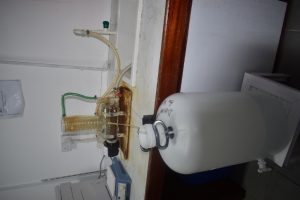
The Distillation Unit is an apparatus that removes impurities and minerals from the water. It also removes the electrical charge from atoms and molecules in water and hence, ensuring more accurate results when used for preparing solutions for analysing and washing of glassware.
The water moves from the tap to the distillation unit into which the impure water is boiled into vapour which is then condensed back to liquid form, which is stored in the container below. The distilled water is also known as pure water, with a conductivity which has to be below 0.05 µS/cm.
Microbiology Section
Monitoring in the Microbiology Section is done on the water samples collected from Water Treatment Plants, Service Reservoirs, Boreholes and Containerized Pressure Filters for bacteriological analysis and the average percentage compliance to standards for the period of July 2018 to June 2019 is 99.4 %.

Daily Process within the Microbiology Laboratory

Below are pictures and details of some equipment being used in the Microbiology Laboratory
Autoclave
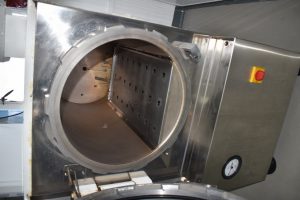
This equipment is used to ensure that tools and broth media are clean and bacteria free before analysing water. Sterilisation occur at 121oC at 15 psi for 30mins.
The autoclave is also meant to decontaminate the used glassware and broth before discarding the latter.
The Oven

At 105oC, Clean and Sterilised sampling bottles and glassware are kept in oven and they have to be removed with care prior to sampling and analysis respectively.
The Drying Cabinet
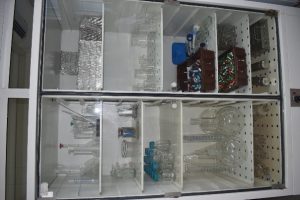
Sterilised Glassware used for preparation of broth medium are kept in the drying cabinet at 105oC to ensure that there are no residues of evaporated water droplets that may cause any kind of contamination.
The Laminar Flow Cabinet
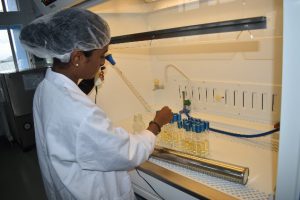
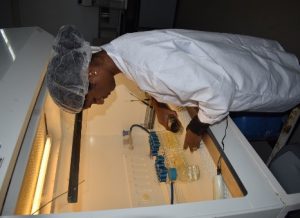
Laminar Flow Cabinet is an enclosed bench that is designed to prevent contamination of samples while dispensing the water sample into the broth medium. Due to the direction of the air flow, the samples and other materials inside the cabinet are actually being protected from the user and the outside environment.
Prior to the Procedure of transferring water samples into tubes filled with broth, removal of the pipettes from canisters has to be performed with utmost care so that they do not touch any other material found in the surrounding.
The Incubator

The equipment is a chamber that provides a suitable temperature for desired Bacteria from water samples to proliferate in specific Broth (Nurturing Medium). The Temperature can be changed manually when required, and monitored on a regular basis for not affecting the lot.
Samples can be kept up to 72hrs depending on the quality of water.
Micro-Algae and Water Quality Surveillance Section
Micro-Algae are described as a group of photosynthetic organisms that many people refer to as “pond scum.” Algae generally grow in lakes, ponds where the water are enriched with nutrients like phosphorus or nitrogen.
The Ministry of Energy and Public Utilities (MEPU) in collaboration with the CWA laboratory established a Water Quality Surveillance programme in the year 2012 to monitor the level of Micro-algae and other physic-chemical parameters in all impounding reservoirs of Mauritius, namely Mare aux Vacoas, Mare Longue, Piton du Milieu, La Nicolière, La Ferme, Bagatelle and Midlands Reservoirs. The WQS programme is ongoing.
When environmental conditions are appropriate, algae can grow very quickly in number. Most species are buoyant and will float to the surface, where they form scum layers or floating mats. When this happens, we call this an “algal bloom.” Algae exist as different groups, namely the Cyanobacteria, Diatoms and Chlorophyta. The group Cyanobacteria is considered as being toxic to human health.
Possibly due to the extensive usage of fertilizers in the agricultural sector, as well as the intensification of farming activities within water catchment areas, there has been a significant impact of nutrients on our water resources. These lead to the degradation of the surface water quality including bad smell, color problems and clogging of filters at the Water Treatment Plants (WTP).
The water quality test comprised of physiochemical, heavy metal, herbicide and microbiological as well as biological parameters.
Once samples are received in the laboratory, trained staff analyse the samples for the identification, enumeration of algae and monitoring of toxic algae.

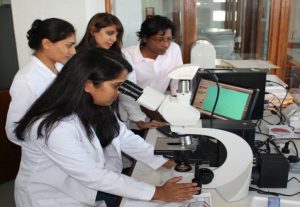
The following pictures show the most common Algae present in our Reservoirs. The pictures were captured with the help of a camera fitted with a microscope equipped with a DIC system. All the algal identification, enumeration and capturing of pictures are being performed at the Water Quality Laboratory of CWA.

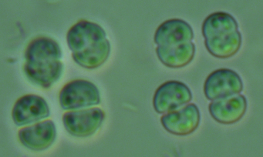
Croococcus sp. of the Cyanobacteria Phylum
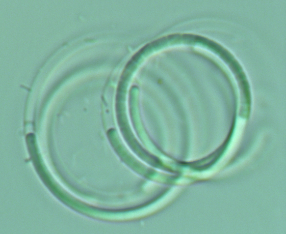

Lyngbya sp. of the Cyanobacteria Phylum
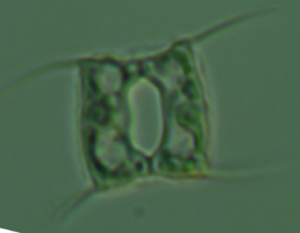
Staurodesmus sp. of the Chlorophyta Phylum
Importance of analyzing Algae in Water
Different types of algae affect different processes of the water treatment plant and may result in problems such as coagulation and clogging of filters. Other water quality problems associated with algae are offensive smell, colour and turbidity in treated water.
Algae as obstacle to volume of water production at water treatment plant:
Clogging of filters are causes more frequent back-washing, thus generating sludge. This process is time consuming and ultimately causes the reduction in the production of water.

Water basins of slow sand filtration at La Marie Water Treatment Plant
Equipment Used for Sampling:
The Fluorometer is a sophisticated probe which can analyse several parameters (physico-chemical and the level of cyanobacteria) on site.
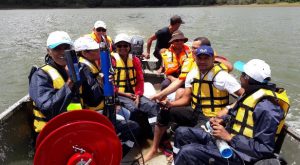

The above pictures show trained staff using the Fluorometer in the middle of La Nicolière Reservoir to analyse the different parameters like physico-chemical, nutrients and level of Cyanobacteria.
Other Activities
As mentioned, the Scientific Services Section is also involved in different works other than water testing.
1. Effluent Discharge Permit (EDP)
A Memorandum of Understanding (MoU) was signed between the CWA and the MEPU for the purpose of Effluent Discharge Permit (EDP), Water Quality Surveillance and Water Pollution Control. The discharge of industrial effluents into the environment are monitored to ensure compliance with standards set under the Effluent Discharge Permit Regulations. Reports on the quality of effluents are submitted to the MEPU on a regular basis for necessary action.
2. Ground Water License
The Water Quality Laboratory monitors the ground water quality and scrutinizes the analytical test reports submitted by the companies which operate individual boreholes for non-domestic and agricultural purposes. Views on water quality are submitted to the Ground Water License Committee for decision on issuing a License.
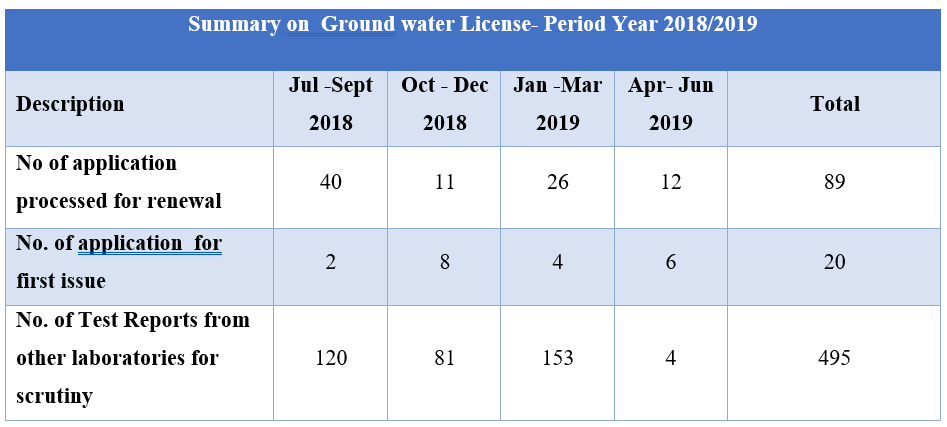
3. Commercial Services & Revenue Generation
The Scientific Services offers testing services for many parameters that concern water and wastewater in both the field of microbiology and chemistry.
4. Sensitization Campaigns
Sensitisation campaigns are done at School levels so as to increase awareness on the importance of keeping our water resources clean. Polluted environment increases the level of nutrients in rivers which causes the proliferation of micro algae in our reservoirs.

